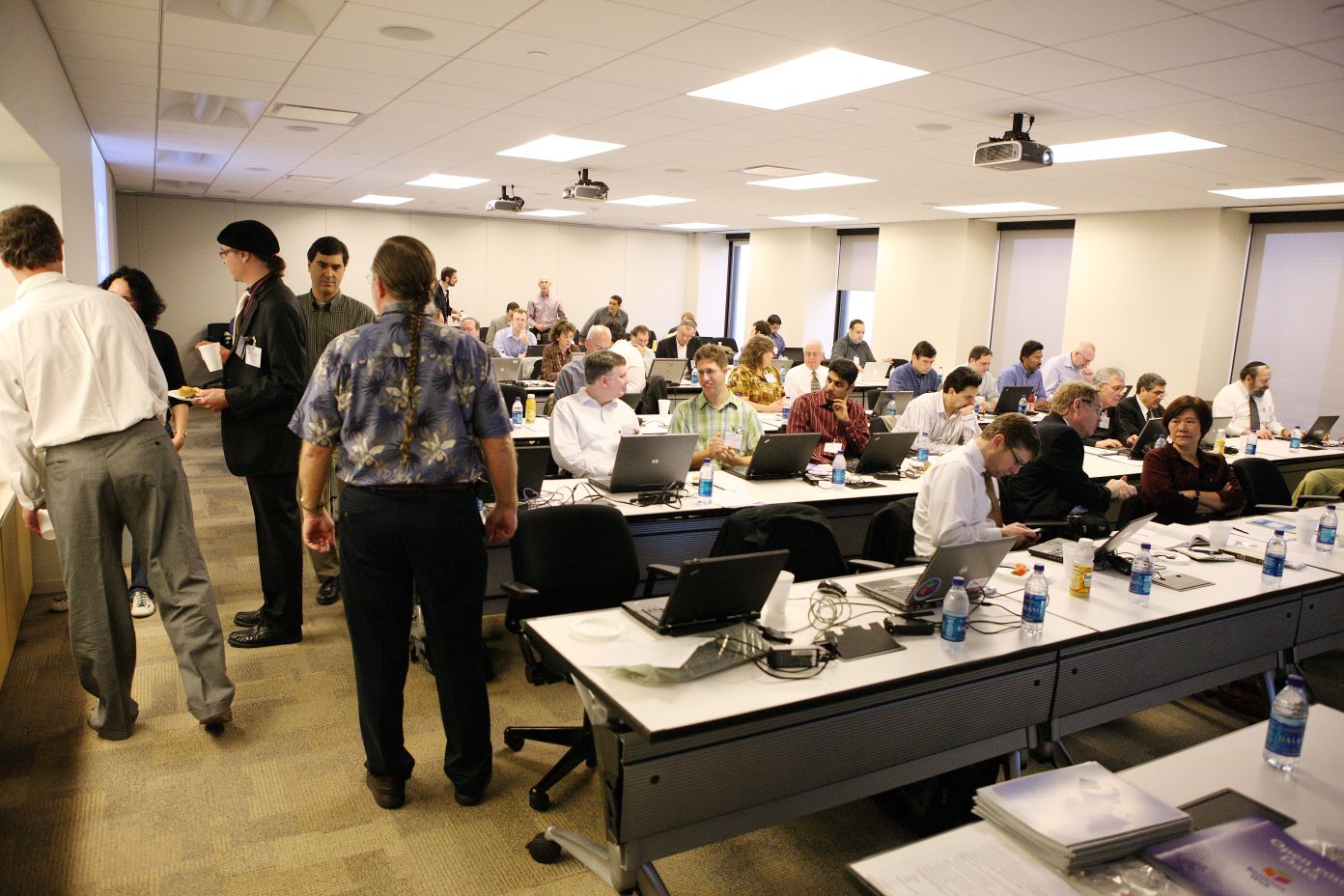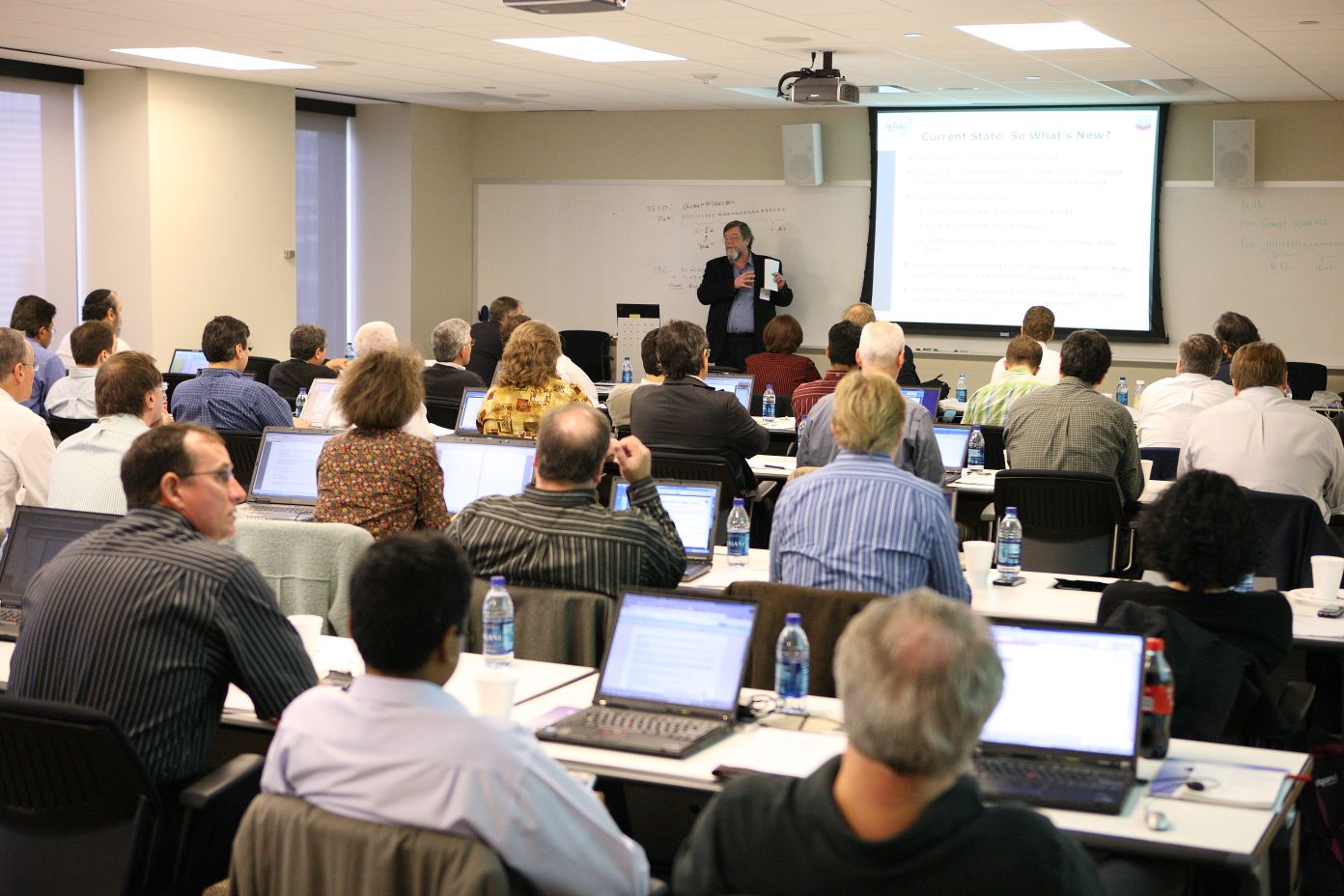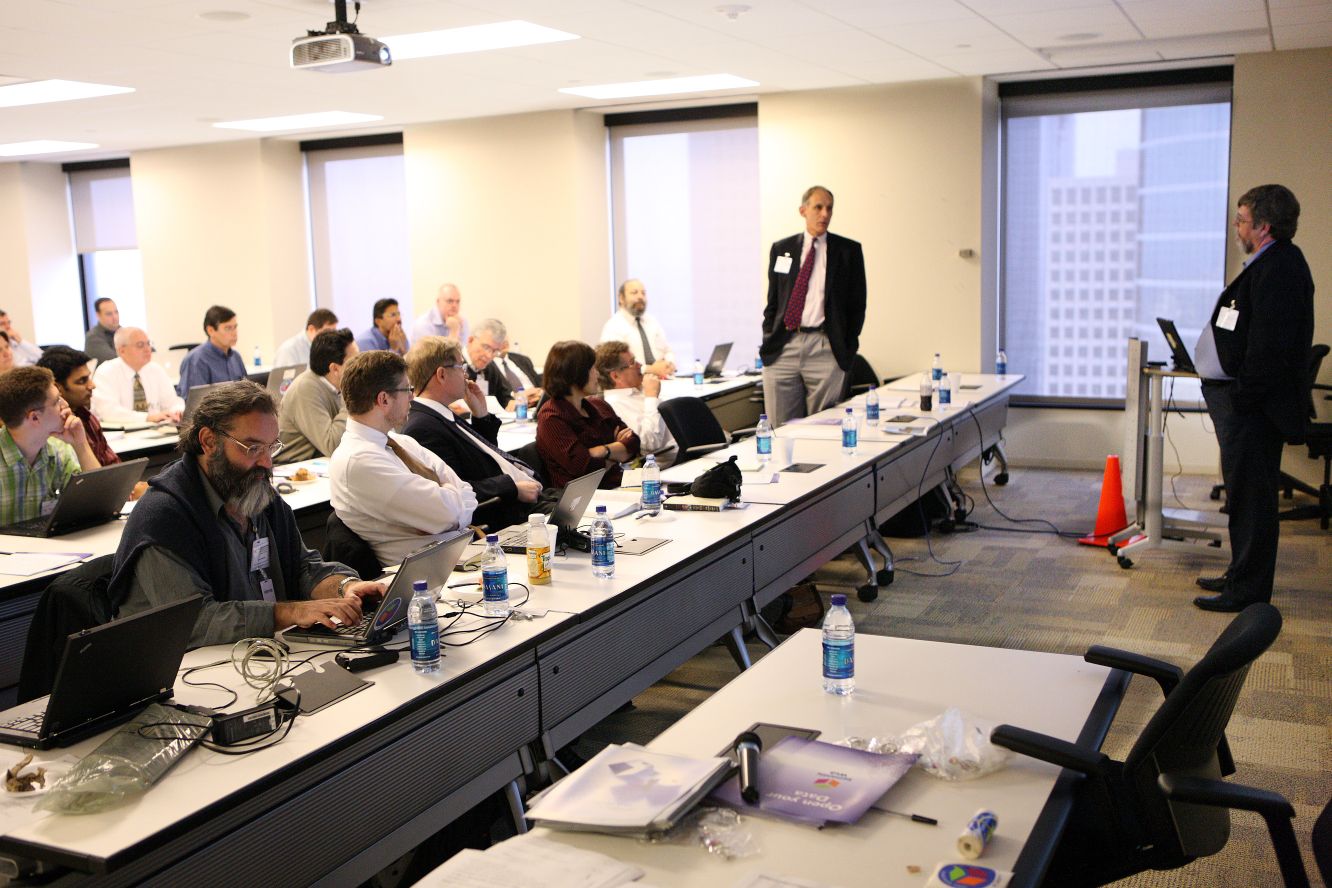Workshop organized by the
World Wide Web Consortium (W3C)
and hosted by
Chevron
Houston,
TX, USA,
9–10 December, 2008
Content

The Oil & Gas (O&G) industry produces a staggering amount of new data every day from a variety of activities such as drilling, exploration and production, reservoir management, major capital projects, facility and downstream operations. The problem of information explosion and overload presents an ever increasing challenge in finding and analyzing information quickly and precisely in order to get the most value for the business. This problem is not unique to the O&G industry; much the same can be said, for example, about the Health Care and Life Science (HCLS) industry, which has embraced Semantic Web technology in order to unite many forms of biological and medical information across diverse industries and institutions through the encoding of meaning into the data and their interpretations. The fundamental question is how Semantic Web technologies might play a similar role in the further development of energy resources. To explore this, W3C organized a workshop with a specific focus on the Oil and Gas industry.
The high level goal of this workshop was to gather and share possible use cases and/or case studies for Semantic Web in the O&G industry in order to understand the business drivers and benefits of using Semantic Web in that particular area of industry. The Workshop also explored whether it is worthwhile to consider the creation of an Incubator, Interest, or Working Group (or Groups) under the auspices of W3C, and the workshop participants attempted to gather enough information for their companies to decide whether to commit substantial resources to such an effort.
Major Oil & Gas companies, energy industry vendors, as well as IT companies and universities were represented at the event. The participants were: Fred VanHorne, May Hsu (BAE Systems); Robin Benjamins, Darius Kanga, Rob DeCarlo (Bechtel); Manoj Dharwadkar, Rahul Patil (Bentley Systems Inc.); Danny Ducharme (BP); Lee Feigenbaum, Sean Martin, Lonnie McCullough (Cambridge Semantics); Jim Crompton, Milind Talpallikar, Scott Hills, Doug Gregory (Chevron); Linda Carruth, Mario Casetta, David Shipley, Frank Chum, Roger Cutler, Ram Soma, Tom Bell (Chevron/ITC); Kendall Clark (Clark & Parsia LLC); David Norheim (Computas); Shawn Holt (Elsevier Engineering and Technology Group), Alan Doniger (Energistics); Jennifer Sampson (Epsis AS); Brooke Aker (Expert System/ENI); Onno Paap (Fluor Corp.); Jean-François Rainaud (Institut Français du Pétrole); Chaminda Peries (Landmark Halliburton); Robert Ewald (National Oilwell Varco); Arthur Keen (Object Reservoir Inc.); Neil McNaughton (Oil IT Journal); David Shimbo (Oracle); Brad Wakefield (Oxy, Inc.); Tom Burchfield, Bethany Crow (Petroleum Abstracts, The University of Tulsa); Dean Forrester (SAIC); Bertrand Du Castel, Najib Abusalbi (Schlumberger); Anil Rode (Shell Information Technology International); Richard Sears (Shell/MIT); Matt Ousdahl (Spectrum Subsea International, Ltd.), Emilio Nunez (The University of Texas at Austin); Philip Pridmore-Brown (Thetus Corporation); Jeremy Carroll, Chip Masters (TopQuadrant); Claude Fauconnet, Raphaële Henri-Bally (TOTAL Holding); Amol Bakshi, Carlo Torniai (University of Southern California); Ivan Herman, Steve Bratt (W3C).
The Workshop, which had very diverse participation, was very successful in generating discussions, hallway conversations, and general community building. The workshop presentations (see the detailed list below) addressed a number of issues of interest for the community.

Jim Crompton, Chevron Manager of Technology & Architecture and Chevron Fellow, gave a keynote address titled “Putting the Focus on Data”, which explored the basic information management challenges in the industry and the potential business value of meeting those challenges. The Oil & Gas industry generates a tremendous amount of information—Chevron alone currently has over 6,000 Terabytes of data, most of it technical. The industry has gotten very good at collecting the data, for example via oil field automation, and has developed tremendous capabilities to use that data to make decisions, for example via modeling and simulation, but there is a tremendous information overload caused by factors such as lack of consistent master data, standards for information exchange, shadow systems, and so on. Jim outlined in general terms an architectural path “back to sanity” and the magnitude of the prize in terms of increasing the value of information.
The Semantic Web applications in to the O&G industry described in these presentations ranged through use cases, strategic research with academia, proof-of-concepts, pilots, and actual deployment. The character of these applications were quite diverse, including: search and reporting in integrated asset management; metadata management of technical earth sciences data; information exchange and integration through international standards and open applications; information management in drilling and production and integrated operations; knowledge management and experience transfer; ontology-based search of earth science documents; and decision support in enhanced oil recovery.
A number of talks focused on the general methodology for creating and managing ontologies used in Semantic Web applications. One useful insight was that there are three general types of potentially useful ontologies:
Roughly speaking, the industry might hope to reuse upper ontologies created elsewhere, collaborate within the industry to develop domain ontologies and use application ontologies in proprietary settings. The tradeoffs between top-down, bottom-up and hybrid ontology development approaches were also discussed. Some examples of ontologies that appeared in various presentations, many of them sharable publicly, include: ISO 15926 (described more fully below); geology (including basic geology, geological boundaries, structures and prospects); EOR (Enhanced Oil Recovery) screening, recovery calculations and scale-up uncertainty; production information based on the PRODML and WITSML standards; drilling information; and business processes described by BPMN. The list above is far from exhaustive because a number of the ontologies were either referenced in passing or were presented in a context that make them difficult to be characterized succinctly.
A number of companies were represented at the workshop that produce tools involved with various aspects of creating and managing Semantic Web ontologies and projects. Some of these vendors presented their wares in contexts related to the industry, and some of the tools showed up in talks from the industry about practical applications. This was useful for attendees who were exposed to some of these tools for the first time. The techniques presented by vendors, by academic and/or use cases presentations, etc., included an expertise locator that was a good example of the cycle of integration, analysis and then back to integration again; tools for the integration of information residing in spreadsheets into a centrally managed ontology; and ontology management, editing, and visualizing tools. Several applications included rule based inferences (beyond ontology based inferences), used Semantic Web repositories in the infrastructure of integration platforms in order to enable organic growth and scaling, or were based on an experience capture and reuse of information in different contexts.
This is a very large ISO standard (see also the corresponding Wikipedia page for further information) which has been under development, and more recently deployment, for over fifteen years. Although the model potentially covers much broader aspects of the industry, to date its primary application has been as an equipment catalog for major capital projects like production facilities. In this context ISO 15926 provides a standard nomenclature for all the components used in the construction of these facilities, ranging from drill bits through flanges and valves to jet engines. Since a single facility can cost billions of dollars and involves thousands of providers of equipment and services, a standardized nomenclature has the potential to drive very significant improvements in cost and efficiency.
Several years ago the original modeling methodology was reformulated using RDF and OWL in order to take advantage of the flexibility and expressivity of these technologies in providing a very general, robust and extensible framework for data models. ISO 15926 repositories can now be accessed via SPARQL and the standard has defined very general templates to make and organize complex statements. Furthermore, a number of important terms have received unique, dereferencable URI-s, which is important for the further usage of Semantic Web technologies in this area.

The primary focus of this panel discussion, moderated by Ivan Herman of the W3C, was the questions of whether Semantic Web technologies have a substantial value proposition for the Oil & Gas industry and whether there are areas in which industry collaboration is appropriate and valuable. There appeared to be a clear consensus in the room that the simple answer to both questions is, “Yes”. Fleshing out the details a bit, part of the value proposition comes from the fact that interfaces to service companies and joint ventures between operators are both extremely common and important in this industry. This naturally leads to an industry culture of collaboration in certain areas and to a clear value proposition for making the information exchange in these encounters more efficient and useful. There was a general feeling that there would be value in sharing domain ontologies, Semantic Web methodologies and best practices, although specific data or business processes would not be sharable for clear business reasons. This leaves a lot of room for collaboration. In addition, there was some feeling that collaboration could expose technical issues that might best be fed back to the W3C processes to influence more general technical solutions. For example, the issue whether the access control mechanisms currently available for the Semantic Web are adequate for their anticipated use in this industry was raised as a point that might be worthy of considerably more discussion. There was also discussion, not leading to any particular consensus about priority, about some of the specific areas in which Semantic Web technology could make a significant impact in the industry.
The panel was composed of Danny Ducharme (BP), Roger Cutler (Chevron). Richard Sears (Shell), Raphaële Henri-Bally (Total) and Bertrand du Castel (Schlumberger).
The moderator of this panel, Jim Crompton of Chevron (who also gave the keynote presentation), started with a succinct summary of some questions that had been answered in this workshop:
But, of course, the next questions are: where do we go from here, what are the next steps, and who is going to be driving?
There was a fairly extensive discussion on previous experiences at the W3C with the HCLS (Health Care & Life Sciences) Interest Group. Some characterizations of the various options for moving forward were also discussed, although that did not lead to any obvious consensus. One clear and useful message from Ivan Herman of the W3C was that if this work were to go forward in a framework provided by the W3C, which was certainly one of the alternatives discussed, it would be necessary to find an organization willing to “lend” the W3C a fellow, i.e., a person to take the lead in organizing the effort. This was not only the model successfully employed by HCLS and other industry areas (e.g., eGovernment), but it would also, in a practical sense, be mandated by manpower constraints in the W3C.
The panel was composed of Robin Benjamins (Bechtel), Frank Chum (Chevron), Alan Doniger (Energistics), Onno Paap (Fluor), Anil Rode (Shell), and Ivan Herman (W3C).
Ivan Herman, Roger Cutler, Frank Chum, and Bertrand du Castel, Workshop organizers
$Id: ogws-report.html,v 1.16 2009/01/13 10:25:16 ivan Exp $